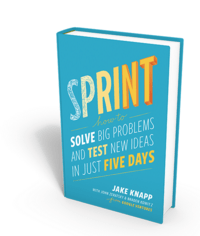
Monday of the sprint week begins with an exercise we call “Start at the End”. It’s a look ahead—to the end of the sprint and beyond. You and your team will lay out the basics: your long-term goal and the difficult questions that must be answered to get there.
When a big problem comes along, it’s natural to want to solve it right away. In your five-day sprint, the clock is ticking, the team is amped up, and solutions start popping into everyone’s mind. But if you don’t first slow down, share what you know, and prioritize, you could end up wasting time and effort on the wrong part of the problem.
Starting at the end is like being handed the keys to a time machine. If you could jump ahead to the end of your sprint, what questions would be answered? If you went six months or a year further into the future, what would have improved about your business as a result of this project? Even when the future seems obvious, it’s worth taking the time to make it specific, and write it down. You’ll start with the project’s long-term goal.
To start the conversation, ask your team these questions: “Why are we doing this project? Where do we want to be six months, a year, or even five years from now?”
The discussion could take anywhere from thirty seconds to thirty minutes. If your team doesn’t quite agree about the goal or there’s any lack of clarity, don’t be embarrassed. But do have a discussion and figure it out. Slowing down might be frustrating for a moment, but the satisfaction and confidence of a clear goal will last all week.
Your goal should reflect your team’s principles and aspirations. Don’t worry about overreaching. The sprint process will help you find a good place to start and make real progress toward even the biggest goal. Once you’ve settled on a long-term goal, write it at the top of the whiteboard. It’ll stay there throughout the sprint as a beacon to keep everyone moving in the same direction.
Okay, time for an attitude adjustment. While writing your long-term goal, you were optimistic. You imagined a perfect future.
Now it’s time to get pessimistic. Imagine you’ve gone forward in time one year, and your project was a disaster. What caused it to fail? How did your goal go wrong?
Lurking beneath every goal are dangerous assumptions. The longer those assumptions remain unexamined, the greater the risk. In your sprint, you have a golden opportunity to ferret out assumptions, turn them into questions, and find some answers.
Just like the goal, these questions guide the solutions and decisions throughout the sprint. They provide a quasi-checklist that you can refer to throughout the week and evaluate after Friday’s test.
List sprint questions
You’ll list out your sprint questions on a second whiteboard. We have a few prompts for getting teams to think about assumptions and questions:
- What questions do we want to answer in this sprint?
- To meet our long-term goal, what has to be true?
- Imagine we travel into the future and our project failed. What might have caused that?
An important part of this exercise is rephrasing assumptions and obstacles into questions. When Blue Bottle Coffee ran a sprint to build an online store, they assumed they could find a way to convey their coffee expertise to new customers, but before the sprint, they weren’t sure how. It’s not difficult to find an assumption such as Blue Bottle’s and turn it into a question:
Q: To reach new customers, what has to be true?
A: They have to trust our expertise.
Q: How can we phrase that as a question?
A: Will customers trust our expertise?
This rephrasing conversation might feel a little weird. Normal people don’t have conversations like this one (unless they’re Jeopardy! contestants). But turning these potential problems into questions makes them easier to track—and easier to answer with sketches, prototypes, and tests. It also creates a subtle shift from uncertainty (which is uncomfortable) to curiosity (which is exciting).
You might end up with only one or two sprint questions. That’s fine. You might come up with a dozen or more. Also, just fine. If you do end up with a long list, don’t worry about deciding which questions are most important. You’ll do that at the end of the day on Monday, when you pick a target for the sprint.
By starting at the end with these questions, you’ll face your fears. Big questions and unknowns can be discomforting, but you’ll feel relieved to see them all listed in one place. You’ll know where you’re headed and what you’re up against.
Jake Knapp is a Design Partner at Google Ventures. He has run more than a hundred sprints with startups such as 23andme, Slack, Nest, and Foundation Medicine. To learn how to run a sprint with your own team, check out Sprint: How to Solve Big Problems and Test New Ideas in Just Five Days.
Related Articles
- Schedule Maker: a Google Sheet to Plan Your Week
- Cancel the New York Times? Good Luck Battling “Dark Patterns”
- How to Start a Career in Behavioral Design
- A Free Course on User Behavior
- User Investment: Make Your Users Do the Work
- Variable Rewards: Want To Hook Users? Drive Them Crazy
- The Hooked Model: How to Manufacture Desire in 4 Steps
